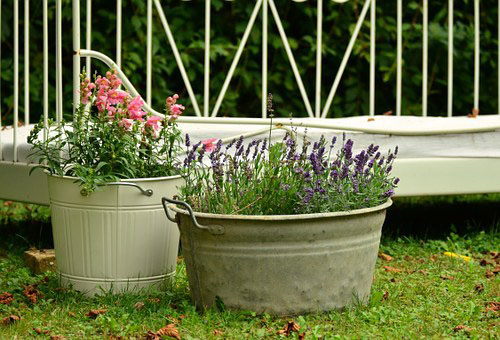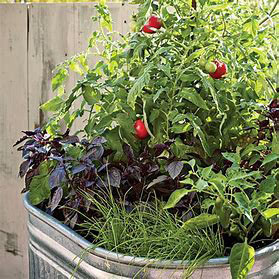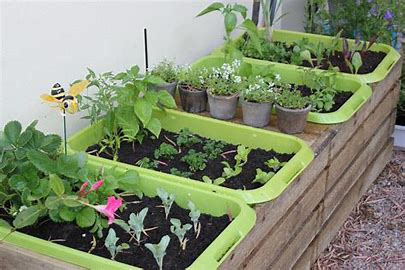
Old metal buckets and wash tubs made great container gardens. Paint them and decorate them for a creative outdoor display.
Whether it is a desire to grow your own herbs, cucumbers, and tomatoes, or beautiful flowers, container gardening is a fun and easy way to do it. Anyone can grow their own food in a container on a deck, porch, or patio, or along a walkway, as long as the spot has plenty of direct sunlight.
The general rule of thumb is: the bigger the container, the better. All containers should have holes in the bottom so the plants do not rot in soggy soil. Newspaper can be placed in the bottom of the container to keep soil in but let excess moisture drain.
Many items can be used for containers, including an old wheelbarrow, tires, a sandbox, an old boat, a plastic kiddie pool, a plastic tote, a five-gallon bucket, an old wash tin, cast concrete shapes, a large livestock tub, wooden half-barrels, or a wooden box (no creosote), as well as fancy and decorative ceramic glazed pots. Hanging baskets also work but need to be watered regularly to secure success. Basically, anything than can hold soil and that can drain can be used.
Use your imagination. Go simple in a five-gallon plastic pail, or be creative and decorate your outside living space, no matter how small, in a beautiful and colorful way.

This old car makes a unique container garden.
Plant a salad garden with a variety of lettuces in a medium-sized container, or go small with an herb garden to spice up your meals. Grow several varieties of vegetables in a large container, being careful not to overcrowd them. Place smaller plants on the outside facing the sun, and larger plants in back. A hill of string beans need at least a square foot or more, tomatoes twice that amount, and zucchini or summer squash three times the space.
In small spaces, stagger the height of containers, with the taller ones in the back, progressing to shorter and shorter toward the full sun. Same-size containers can be used on the edge of stairs, or on a step ladder, or on homemade wooden stairs built specifically for the containers you plan to use.

A large livestock tub can grow multiple plants, but use caution and do not overcrowd. (Paula Roberts photo)
If raising cucumbers, tomatoes, or cucumbers, be sure to put a trellis, a stake, or some chicken wire on a frame for the plants to climb up onto. This will also make it easier to harvest the fruits of your labor, as they will be easily visible and at an easy picking height.
There are many dwarf varieties of vegetables available, so be sure to read the seed package or ask your nursery if purchasing seedlings.
Intersperse edible landscape with brightly colored flowers for a truly gorgeous backyard or patio.
Greens, such as lettuce, spinach, and Swiss chard can be some of the easiest to grow.
Light-colored containers reduce heat absorption.
Mulch to prevent water loss. Water in the early morning or at sunset to cut down on water evaporation.
Put containers up on small blocks of wood or flat stones or cement, so soil can drain.
Some basic rules for beginner include: don’t skimp on drainage, place in good sun (6-8 hours full sun), add slow-release fertilizer to potting soil, don’t overcrowd, and know how big a plant will get before you plant it.
Common mistakes of container gardening are: using too small a container, using too much or too little water, overcrowding, not enough sun, or staking or caging too late.
Mix slow-release organic fertilizer with potting mix. The more soil used, the better, as it will not dry out as fast.

Plastic totes make a simple container for container gardening, but make sure they have drain holes drilled in the bottom of them. (Paula Roberts photo)
Plant seeds when the soil reaches a temperature of 70 degrees F. An old farmer I knew used to joke that the soil was “ready to plant when you could sit on it with a bare butt and it felt warm.”
Containers need to be watered consistently. The soil needs to be moist, not wet. There are self-watering and -fertilizing containers out there, but they can be costly.
A light, airy soil mix should be used. Garden soil can be used but needs to be amended. Use one part soil, one part peat moss, and one part perlite or coarse building sand (not beach or play sand). The disadvantage of using garden soil is it may contain pests, weed seeds, and disease organisms. The advantage of using soilless media is they are usually free of these things and will not dry out as fast.
Planting soil is available at numerous hardware stores in Lincoln County and is available in bulk from several greenhouses in the area. Call ahead to make sure it is on hand.
Before setting seedlings out in direct sun, it is important to acclimate them to the outside so they are hardier. Keep them in a garage or enclosed porch so they get used to the cold. Open the garage door or porch windows during the day so they get used to the wind blowing on them to toughen them up.
Be creative, have fun – and good eating!



